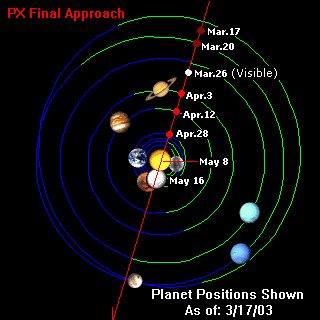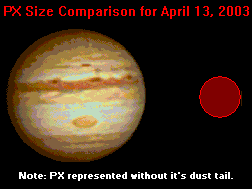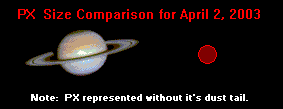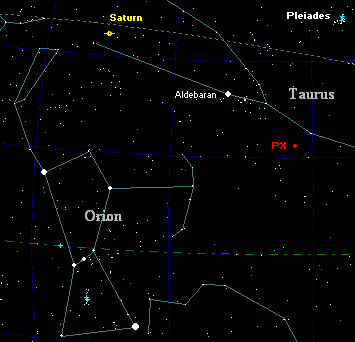

 |
 |
SENTINEL |
Date: 3/19/03 7:27:54 AM Pacific Standard Time
Kent:
Here is a final graphic to illustrate PX's final approach time line according to the data provided by ZetaTalk. The planetary positions are shown as of March 17, 2003, when PX's rapid approach brought it within Pluto's mean orbital distance of 3.6 billion miles from the Sun. Keep in mind that by May 16th, the Earth will have orbited counter-clockwise to the 7:00 position in the orbital chart, just short of PX's path.

We should know for certain by March 26 - 27th if not sooner if PX is a real threat or not , as it's approach toward the Sun brings it close enough to begin illuminating PX and it's dust tail with reflected sunlight. It should initially appear as a faint fuzzy star or nebula. It should continue to rapidly brighten, redden and it's tail become more clearly defined after that date as it continues it's approach toward the Sun. Let's all pray for a no-show.... and a stop to WWIII while you're at it.
Date: 3/31/03 8:29:30 AM Pacific Standard Time
Kent:
Here are two size guides which illustrate the relevant or observed size of PX as compared to Saturn and Jupiter for the dates that PX is projected to pass these two planets. These observational guides are based upon ZetaTalk's data, which states PX is roughly 4 times the diameter of the Earth. If your telescope or binoculars are strong enough to distinguish Saturn's moons, then you should be able to clearly view PX by now if Zetatalk's information is accurate. Keep in mind that PX's dust tail will make it appear larger than shown in these examples, but will also make it more poorly defined than Saturn and Jupiter. It should initially appear as a faint reddish smudge, similar to a nebula.


Here is a starmap to use as a sighting guide.

Let's hope that this turns out to be the biggest April Fools joke of all time.